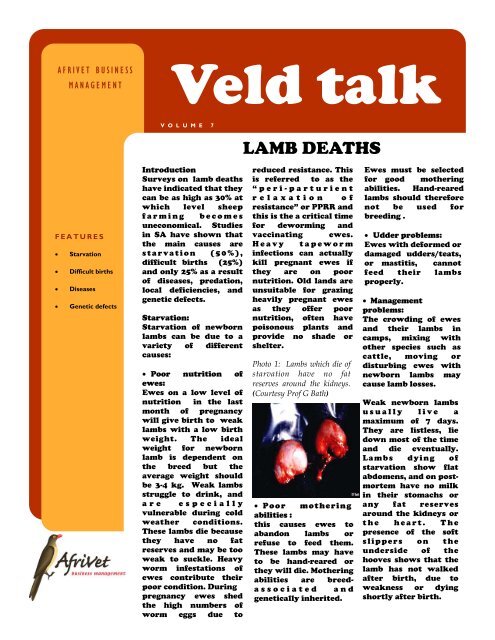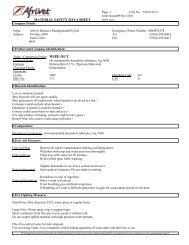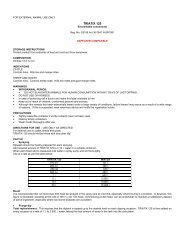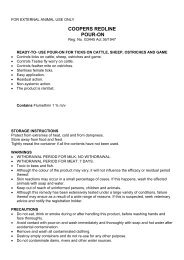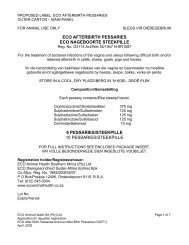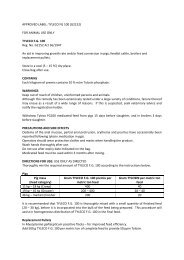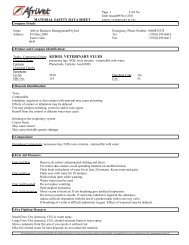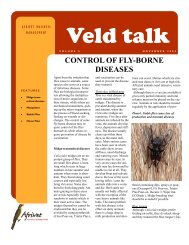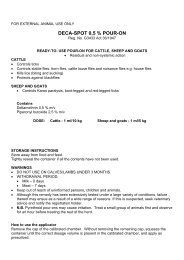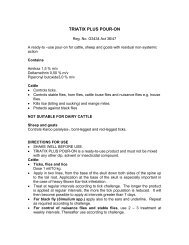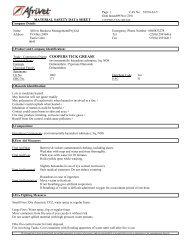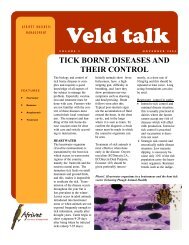Lamb deaths.pdf - Afrivet
Lamb deaths.pdf - Afrivet
Lamb deaths.pdf - Afrivet
You also want an ePaper? Increase the reach of your titles
YUMPU automatically turns print PDFs into web optimized ePapers that Google loves.
AFRIVET BUSINESS<br />
MANAGEMENT<br />
Veld talk<br />
FEATURES<br />
• Starvation<br />
• Difficult births<br />
• Diseases<br />
• Genetic defects<br />
V O L U M E 7<br />
Introduction<br />
Surveys on lamb <strong>deaths</strong><br />
have indicated that they<br />
can be as high as 30% at<br />
which level sheep<br />
farming becomes<br />
uneconomical. Studies<br />
in SA have shown that<br />
the main causes are<br />
starvation (50%),<br />
difficult births (25%)<br />
and only 25% as a result<br />
of diseases, predation,<br />
local deficiencies, and<br />
genetic defects.<br />
Starvation:<br />
Starvation of newborn<br />
lambs can be due to a<br />
variety of different<br />
causes:<br />
• Poor nutrition of<br />
ewes:<br />
Ewes on a low level of<br />
nutrition in the last<br />
month of pregnancy<br />
will give birth to weak<br />
lambs with a low birth<br />
weight. The ideal<br />
weight for newborn<br />
lamb is dependent on<br />
the breed but the<br />
average weight should<br />
be 3-4 kg. Weak lambs<br />
struggle to drink, and<br />
are especially<br />
vulnerable during cold<br />
weather conditions.<br />
These lambs die because<br />
they have no fat<br />
reserves and may be too<br />
weak to suckle. Heavy<br />
worm infestations of<br />
ewes contribute their<br />
poor condition. During<br />
pregnancy ewes shed<br />
the high numbers of<br />
worm eggs due to<br />
LAMB DEATHS<br />
reduced resistance. This<br />
is referred to as the<br />
“peri-parturient<br />
relaxation of<br />
resistance” or PPRR and<br />
this is the a critical time<br />
for deworming and<br />
vaccinating ewes.<br />
Heavy tapeworm<br />
infections can actually<br />
kill pregnant ewes if<br />
they are on poor<br />
nutrition. Old lands are<br />
unsuitable for grazing<br />
heavily pregnant ewes<br />
as they offer poor<br />
nutrition, often have<br />
poisonous plants and<br />
provide no shade or<br />
shelter.<br />
Photo 1: <strong>Lamb</strong>s which die of<br />
starvation have no fat<br />
reserves around the kidneys.<br />
(Courtesy Prof G Bath)<br />
• Poor mothering<br />
abilities :<br />
this causes ewes to<br />
abandon lambs or<br />
refuse to feed them.<br />
These lambs may have<br />
to be hand-reared or<br />
they will die. Mothering<br />
abilities are breedassociated<br />
and<br />
genetically inherited.<br />
Ewes must be selected<br />
for good mothering<br />
abilities. Hand-reared<br />
lambs should therefore<br />
not be used for<br />
breeding .<br />
• Udder problems:<br />
Ewes with deformed or<br />
damaged udders/teats,<br />
or mastitis, cannot<br />
feed their lambs<br />
properly.<br />
• Management<br />
problems:<br />
The crowding of ewes<br />
and their lambs in<br />
camps, mixing with<br />
other species such as<br />
cattle, moving or<br />
disturbing ewes with<br />
newborn lambs may<br />
cause lamb losses.<br />
Weak newborn lambs<br />
usually live a<br />
maximum of 7 days.<br />
They are listless, lie<br />
down most of the time<br />
and die eventually.<br />
<strong>Lamb</strong>s dying of<br />
starvation show flat<br />
abdomens, and on postmortem<br />
have no milk<br />
in their stomachs or<br />
any fat reserves<br />
around the kidneys or<br />
the heart. The<br />
presence of the soft<br />
slippers on the<br />
underside of the<br />
hooves shows that the<br />
lamb has not walked<br />
after birth, due to<br />
weakness or dying<br />
shortly after birth.
PAGE 2<br />
Weak lambs should be given<br />
a 20% glucose solution (40-<br />
100ml) which can be injected<br />
into the abdomen or given<br />
per stomach tube. Colostrum<br />
can be stored in a freezer and<br />
used for feeding orphan or<br />
rejected lambs.<br />
Difficult births (dystocias)<br />
<strong>Lamb</strong>s often die after<br />
difficult births due to<br />
suffocation in the birth<br />
canal. On a post mortem it<br />
will be clearly seen that the<br />
lungs were never filled with<br />
air. The heads of these lambs<br />
are often swollen as a result<br />
of being trapped in the birth<br />
canal. The cause of difficult<br />
births is usually lambs being<br />
too big or weakness of the<br />
ewe. Fat overfed ewes may<br />
also have lambing<br />
difficulties.<br />
Photo 2: A lamb which died after<br />
a dystocia . Note the “slippers”<br />
on the feet which show that it<br />
has never walked (Courtesy Prof<br />
G Bath)<br />
Diseases causing lamb <strong>deaths</strong><br />
Enzootic abortion<br />
Enzootic abortion is an<br />
infectious condition caused<br />
by the organism Chlamydia<br />
psittaci. It is transmitted<br />
from sheep to sheep and is<br />
usually introduced by new<br />
sheep coming into the flock.<br />
The disease causes abortions<br />
in late pregnancy, or<br />
resorption which is<br />
indicated by a low lambing<br />
percentage. Premature,<br />
stillborn or weak lambs can<br />
also be seen. Infected lambs<br />
are often too weak to stand<br />
or drink, may either have<br />
pneumonia or joint<br />
infections. The diagnosis of<br />
enzootic abortion is made<br />
based on the history and<br />
examination of the aborted<br />
foetuses by a vet or a<br />
veterinary laboratory.<br />
Serology of unvaccinated<br />
flocks can confirm the<br />
presence of the disease.<br />
Vaccination of ewes 6 weeks<br />
before the breeding season<br />
will prevent abortion and<br />
lamb losses.<br />
Photo 3: A weak lamb born to a<br />
ewe infected with enzootic<br />
abortion. (Courtesy Prof G<br />
Bath)<br />
<strong>Lamb</strong> dysentery<br />
<strong>Lamb</strong> dysentery occurs<br />
sporadically in SA, caused<br />
by Clostridium perfringens<br />
B. The disease only occurs in<br />
the first 7-14 days of life.<br />
Affected lambs show pain,<br />
listlessness, bloody<br />
diarrhoea and die very<br />
quickly. On post mortem the<br />
stomach is filled with blood<br />
and shows ulceration. The<br />
condition can be prevented<br />
by vaccination with a<br />
clostridial vaccine<br />
containing type B. The ewes<br />
must be vaccinated twice<br />
with a 3-4 week interval,<br />
the booster being given a<br />
month before lambing.<br />
Multi-component vaccines<br />
such as Covexin 10, Ovivax 6<br />
or Tasvax PK Plus are<br />
suitable, depending on<br />
specific requirements<br />
Colibacillosis<br />
Although E. coli infections<br />
are much more common in<br />
calves than lambs, the<br />
disease may cause problems<br />
when ewes lamb in camps<br />
under intensive conditions.<br />
The lambs develop<br />
diarrhoea, dehydration and<br />
rapid death within the first<br />
week of life. The use of the<br />
E. coli vaccine will reduce<br />
the prevalence but only if<br />
lambs get sufficient<br />
colostrum<br />
Tetanus<br />
The use of elastrators to<br />
castrate and amputate the tails<br />
of lambs, creates ideal<br />
conditions for the development<br />
of tetanus. The wounds become<br />
infected with Clostridium<br />
tetani bacteria which multiply<br />
in the strangulated tissue and<br />
produce the tetanus toxin. The<br />
toxin causes spastic paralysis<br />
which later leads to the death<br />
of the lamb. The ideal age for<br />
tail amputations and castration<br />
is 3 weeks of age when the<br />
lambs have a high level of<br />
colostral immunity.<br />
VELD TALK
VOLUME 7<br />
PAGE 3<br />
The ewes must be<br />
vaccinated with a C. tetani<br />
containing vaccine at least<br />
twice, the booster given 2-<br />
3 weeks before lambing, to<br />
give optimal antibody<br />
levels.<br />
Suitable vaccines are<br />
Ovivax 6 or Covexin 10.<br />
Orf<br />
Orf is a condition caused by<br />
a virus which causes a wartlike<br />
growth on the skin.<br />
The lesions occur especially<br />
around the mouths of lambs<br />
as well as on the udders of<br />
ewes. Suckling lambs<br />
refuse drink because of the<br />
discomfort caused by the<br />
sores. Ewes can develop<br />
mastitis and refuse to feed<br />
their lambs. A vaccine is<br />
available but management<br />
factors like preventing<br />
ewes feeding on thorny<br />
shrubs can also reduce the<br />
incidence.<br />
The orf vaccine is applied<br />
by scratching the skin with<br />
a needle and dropping the<br />
vaccine onto its surface.<br />
Rift Valley fever (SDK)<br />
RVF is a virus disease<br />
which occurs sporadically<br />
in SA. The last outbreaks<br />
were in 1970 and although<br />
the virus is still present in<br />
mosquitoes the optimal<br />
conditions need for the<br />
multiplication of the<br />
specific mosquitoes have<br />
not occurred for the last<br />
few decades i.e. early heavy<br />
summer rains which result<br />
in the formation of pans.<br />
Under these conditions the<br />
specific mosquitoes which<br />
transmit RVF multiply to<br />
enormous numbers. The<br />
mosquitoes which transmit<br />
RVF have a preference for<br />
livestock – sheep, cattle<br />
and goats. Up to 100%<br />
pregnant animals can<br />
abort, and large<br />
percentages of young<br />
lambs, kids and calves may<br />
die. It is estimated that<br />
millions died during the<br />
outbreaks in the 1970s.<br />
Effective vaccines are<br />
available and must be<br />
administered in the spring.<br />
Other causes of abortions<br />
Other causes of abortions<br />
in sheep and goats are<br />
Brucella melitensis,<br />
Coxiella burnetti and<br />
Toxoplasma gondii. In<br />
Angora goats habitual<br />
abortions occur as a result<br />
of metabolic stress or<br />
genetic defects caused by<br />
inbreeding.<br />
Genetic defects<br />
A low percentage of birth<br />
defects may occur in<br />
flocks due to genetic<br />
causes. Malformed jaws,<br />
limbs, skin and lack of an<br />
anus are the most common.<br />
Deformed lambs that<br />
survive should not be used<br />
for breeding. Certain<br />
viruses, such as Akabane<br />
virus which is prevalent in<br />
the summer, can cause<br />
foetal abnormalities.<br />
Vaccination with blue<br />
tongue vaccine in the first<br />
two months of pregnancy<br />
can cause brain and<br />
nervous system<br />
deformities. The vaccine<br />
should be used in the<br />
second half of pregnancy<br />
when it doesn’t cause<br />
problems.<br />
Summary of prevention<br />
of lamb losses<br />
1 Examine ewes at<br />
weaning for dry or<br />
hard udders, teats<br />
which are too large or<br />
which don’t have<br />
openings. These ewes<br />
should be culled.<br />
2 Vaccinate ewes<br />
with Enzootic<br />
Abortion vaccine<br />
before the breeding<br />
season<br />
3 E n s u r e g o o d<br />
nutrition of<br />
pregnant ewes and<br />
deworm them 4-6<br />
weeks before<br />
lambing. Ovivax 6<br />
deworms and<br />
v a c c i n a t e s<br />
simultaneously.<br />
4 Give a booster<br />
injection of a<br />
multicomponent<br />
clostridial vaccine<br />
such as Covexin 10<br />
a month before<br />
lambing to protect<br />
the ewe and the<br />
lamb.<br />
5 Supervision by a<br />
shepherd during<br />
lambing will<br />
identify poor<br />
mothers and<br />
difficult lambers.<br />
6 <strong>Lamb</strong>ing camps must<br />
be hygienic and<br />
provide shelter<br />
against the wind.<br />
7 D o n ’ t c r o w d<br />
lambing ewes or<br />
disturb them<br />
unnecessarily.<br />
8 Cull ewes that don’t<br />
raise lambs<br />
successfully and<br />
don’t breed from<br />
their offspring.
PAGE 4<br />
Condition Cause Age Control<br />
Coccidiosis Coccidia (Eimeria, Isospora)<br />
Feedlot lambs<br />
(3-5 months)<br />
Less often at 2-8<br />
weeks<br />
Treatment and medication<br />
of feed<br />
Pulpy kidney C. perfringens D <strong>Lamb</strong>s 2-12 months Vaccination at 4-5<br />
months with Tasvax<br />
PK Plus or broader<br />
spectrum like Ovivax<br />
6 or Covexin 10.<br />
Septicaemic pasteurellosis<br />
P. haemolytica <strong>Lamb</strong>s 2 -12 months Vaccination of lambs<br />
1-2 weeks old or of<br />
ewes during pregnancy<br />
Pneumonia P. haemolytica Suckling lambs from<br />
2 weeks to 2 months<br />
<strong>Lamb</strong>s in feedlots<br />
Vaccination of ewes<br />
during pregnancy<br />
Vaccination of lambs<br />
1-2 weeks old or of<br />
ewes during pregnancy


